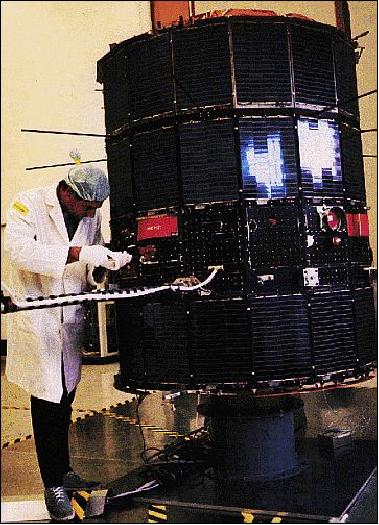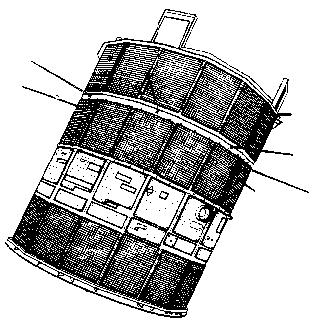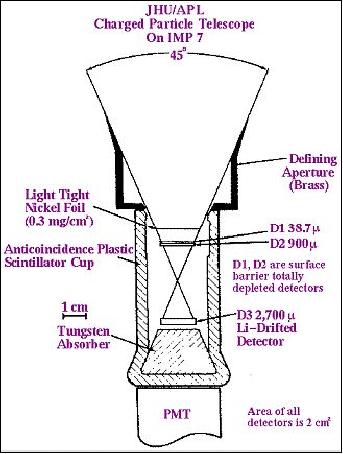IMP-8 (International Monitoring Platform - 8) / EXPLORER 50
EO
Cancelled
Atmosphere
NASA
Quick facts
Overview
| Mission type | EO |
| Agency | NASA |
| Mission status | Cancelled |
| Measurement domain | Atmosphere, Gravity and Magnetic Fields |
| Measurement category | Gravity, Magnetic and Geodynamic measurements, Atmospheric Winds |
| Measurement detailed | Atmospheric stability index, Gravity field, Electric Field (vector) |
| Instrument type | Earth radiation budget radiometers, Space environment, Magnetic field, Other, Atmospheric chemistry, Communications, Data collection, Gravity instruments |
| CEOS EO Handbook | See IMP-8 (International Monitoring Platform - 8) / EXPLORER 50 summary |
IMP-8 (International Monitoring Platform - 8)
IMP-8 is a NASA/GSFC mission - also known by the names of Explorer 50, and IMP-J (COSPAR designation: 73-078A). IMP-8 is the last in a series of ten IMP missions with the primary objective to perform detailed and near-continuous observations of the Sun/Earth environment (solar wind monitoring, measuring the plasma/field environment of the magnetosheath and the magnetotail). The IMP-8 mission is part of NASA's Sun-Earth Connections research program.

Spacecraft
The IMP 8 spacecraft was built, and has been operated over its lifetime, at NASA's Goddard Space Flight Center. IMP-8 is a 16-sided drum-shaped spacecraft of 135.6 cm diameter and 157.4 cm high. It is spin-stabilized at 22.3 rpm. The spin axis is oriented normal to the ecliptic plane within 1º. The spacecraft has a launch mass of 410 kg (dry mass of 371 kg) The nominal power is 150 W.
RF Communications
The telemetry data rate is 1.6 kbit/s (VHF-band). Since the spacecraft has no on-board data storage, tracking is an important issue in determining data availability. The tracking obtained relies on an ad hoc network of VHF (Very High Frequency) ground stations. Tracking stations involved in the mission: Wallops Island, VA; Redu, Belgium; Tasmania, Australia, Santiago de Chile; and Hawaii. - During the early years of the mission the tracking averaged about 90% each year, but this diminished to 60-70% during most of the 1980's and early 1990's. Since November 1997 the tracking has averaged 90-95%, which is the best tracking coverage in over 20 years. 1) 2) 3)


Figure 3: Artist's view of the deployed IMP-8 spacecraft in orbit (image credit: NASA)
Launch
The launch of IMP-8 took place on Oct. 26, 1973 from the Eastern Test Range (Cape Canaveral, FLA) by a Delta vehicle.
Orbit
Geocentric elliptical orbit, apogee = 247,267 km, perigee = 189,024 km, inclination varies between 0-55º with a periodicity of several years, period = 12.6 days, spin vector direction= normal to ecliptic. IMP-8 spends 60% or more of each 12-day orbit in the solar wind, and the rest of its time in the magnetosheath and magnetosphere.
Note: The initial orbit was more elliptical than intended, with apogee and perigee distances of about 45 and 25 RE (Earth radii). Over the first 10 years of the mission the eccentricity declined from near 0.3 at launch to 0.2 in early 1975, after which it has remained below 0.2. The actual value has varied between 0.06 and 0.33, with a mean near 0.12 (which corresponds to apogee and perigee heights of ~38 and ~30 RE, respectively). Thus, while the initial orbital eccentricity of 0.33 yielded apogee and perigee distances as extreme as 45 RE and 22 RE, the more common eccentricity of less than 0.2 has kept IMP-8's geocentric distance in the 30-40 RE range.
Mission Status
• Although the NASA IMP-8 mission officially ended in October 2001, partial data recovery continued through 2006. The IMP-8 data stream stopped permanetly in October 2006, after a passage through the Earth's shadow without power-down precautions led to severe degradation in the satellite's downlink (total on-orbit service of IMP-8 for 33 years). - The IMP-8 CRNE (aka CHE) instrument returned data from 1973 to 2006. The CRNE particle telescope was designed to measure the isotopic composition of GCR (Galactic Cosmic-Ray ) nuclei and has also been used in many studies of protons and ions above 10 MeV/nucleon from solar energetic particle (SEP) events. 4)
• After the decommissioning by NASA in October 2001, the IMP-8 spacecraft was resurrected again for a further extended mission. Telemetry acquisition resumed after about three months at Canberra only (30-50% coverage), as an adjunct to the Voyager and Ulysses missions. As of August 2005 IMP-8 continued in this mode.
- The current operating instruments include: CPME (APL), CHE (formerly Chicago, now UNH). The data acquisition is being supported by one station only (Canberra), commanding from Wallops or Santiago. 5)
The objectives of the extended mission were similar to the original goals with emphasis on providing solar wind parameters as input for magnetospheric studies, as 1-AU baseline for deep-space studies, and to continue solar cycle variations studies with a single set of well-calibrated and understood instruments.
- IMP-8 Status in April 2005: All supported instruments (Goddard, MIT, Chicago-UNH, APL-Kansas) are operating normally. Canberra antenna is routinely acquiring IMP-8 data daily. Ground data reduction at Kansas remains current with ~1 week average delay in postings. 6)
• NASA decommissioned the IMP-8 spacecraft on Oct. 28, 2001 after 28 years on duty (due to budget constraints). IMP-8 was an important adjunct to the ISTP program (CPME and EPE instruments), providing 1 AU baseline data for the deep space Pioneer, Voyager, Helios, and Ulysses missions. It also was the longest-lived geocentric space physics mission NASA has ever flown. IMP-8 generated a wealth of high-quality data that have led to new discoveries and have resulted in hundreds of publications. 7) 8) 9)
• On Oct. 23, 1998, the IMP-8 mission continued to make valuable observations a quarter century after its launch. Over the past 25 years, more than one thousand scientific papers have been published in the refereed scientific literature in which IMP-8 data were the sole data used or were important adjuncts to data from other missions.
Sensor Complement
The spacecraft has an onboard array of field, particle, and plasma instruments providing at the time period the only near-Earth, solar wind, and cosmic ray monitor to support heliospheric, solar variability, cosmic ray, and magnetospheric studies. The sensor complement provides baseline solar wind data for the ISTP (International Solar Terrestrial Physics) program.
Field Investigations
MAG (Magnetic Fields Experiment), PI: R. Lepping, GSFC. MAG is a boom-mounted triaxial fluxgate magnetometer. The objectives are the study of the interplanetary, geomagnetic tail, and boundary magnetic fields. Instrument mass=3.2 kg, in the range of ± 36 nT per sensor. The resolution per sensor is ± 0.3 nT. Vector measurements are performed every 40 ms. The magnetometer failed June 10, 2000. 10)
The experiment operated nominally from launch until mid-1975. On July 11, 1975, because of a range change problem, the experiment operation was frozen into the 36 nT range. The digitization accuracy in this range is about ± 0.14 nT. On March 23, 1978, the sensor flipper failed. After that time, alternative methods of Z-axis sensor zero-level determination were required. Key parameters for the magnetometer investigation are computed within the ISTP/CDHF for a week of data at a time. Generally key parameter availability lags real time by about 14 days.
GAF (DC Electric Fields Investigation), PI: T. L. Aggson, GSFC. Instrument (mass=11.5 kg) utilizes two 60 m wire antennas to measure DC electric fields in the solar wind and magnetosheath.
IOF (AC Electric and Magnetic Fields Experiment), PI: D. A. Gurnett, University of Iowa. The plasma wave instrumentation (mass=12 kg) consists of a 121.8 m tip-to-tip dipole antenna for electric field measurements (in the S/C spin plane) and a triaxial search coil for magnetic field measurements. Magnetic measurements are made in seven channels in the frequency range 40 Hz to 1.78 kHz (cycle time of 10.24 s for one set of measurements). The electric field is measured by a 15 channel spectrum analyzer operating between 40 Hz and 178 kHz, and a wide band receiver tunable to 2000, 500, 125, and 31.1 kHz.
Plasma Investigations
LAP (Los Alamos Plasma Experiment), PI: S. J. Bane, Los Alamos National Laboratory. Solar Plasma Electrostatic Analyzer Experiment. The instrument (mass=6.3 kg) consists of a hemispherical plate electrostatic analyzer for the measurement of ion and electron distributions. Resolution time < 2 minutes.
IOE (Low Energy Particles Investigation), PI: L. A. Frank, University of Iowa. The instrument (mass=2.6 kg) consists of a Low-Energy Proton and Electron Differential Energy Analyzer (LEPEDA) and a Geiger tube. LEPEDA measures fluxes of ions and electrons, separately and simultaneously, in each of 16 energy per charge channels (between 50 eV and 45 keV) in each of 16 azimuthal directions around the S/C spin vector. The Geiger tube measures electrons in the range > 45 keV. A full measurement cycle = 82 seconds.
PLA (Plasma Faraday Cup Assembly), PI: A. Lazarus, MIT. The objective is to study the positive ions and electrons in the solar wind, transition region, and magnetotail. Parameters derived on a routine basis are proton velocity, number density, and temperature (most probable thermal speed). The instrument (mass=6.5 kg) consists of a split collector Faraday cup measuring ions in the energy range of 50 eV/q to 7 keV/q in 24 steps, and electrons in the range from 22 eV/q to 2 keV/q in 21 steps. An angular distribution is taken at each energy step. The measurement sequence is controlled by the measured flux. Typical measurements are 30 seconds in the solar wind and magnetosheath.
The instrument has three operating modes. The tracking mode yields the best time resolution which is about 1 minute. A single energy window is used during a spacecraft rotation. The ion spectrum is obtained in eight spacecraft revolutions using a subset of the energy windows that track the peak of the solar wind. In this mode, fluxes are measured during 11.25º sectors of the spacecraft spin while the instrument is looking within the 90º sector centered on the sun direction and during 45º sectors for the remainder of the rotation. The other modes yield a spectrum using all 24 windows (with the same angular sectors described above) or a spectrum that results from integrating the observed fluxes over 45º sectors for the entire spacecraft rotation.
Parameters derived on a routine basis are proton velocity, number density, and temperature (most probable thermal speed). Those parameters are obtained from a non-linear, least-squares fit to the observed fluxes using a convected, isotropic Maxwellian model. 11)
Energetic Particle Investigations
EPE (Energetic Particle Experiment), PI: D. J. Williams, NOAA. The instrument (mass=3.3 kg) is a solid-state telescope which measures fluxes of ions in four energy channels ranging from 0.05 - 0.20 MeV to 2.1 - 4.5 MeV, and electrons in the ranges 30-90 and 100-200 keV.
The EPE particle detector assembly consists of a main magnet-detector assembly and two auxiliary detector heads. All detectors are fully depleted, surface barrier, solid state detectors, and are operated with bias voltages 1.25-1.5 times the values required for full depletion. To minimize radiation damage effects, all detectors directly exposed to ion fluxes are mounted with the aluminum contact exposed to the incoming beam.
The main detector assembly consists of (i) a three-element telescope (detectors A, B, and C), (ii) a sweeping magnet that keeps low energy electrons (Ee<=200-300 keV) away from the telescope, and (iii) two detectors (D and E) to detect the swept electrons. The telescope covers the proton energy range 50 keV ≤ Ep ≤ 25 MeV and the alpha particle range 2.2 MeV ≤ Ea ≤ 35 MeV. Detectors D and E cover the electron energy range 30 keV ≤ Ee ≤ 200 keV.
EECA (Electrostatic Energy-Charge Analyzer), PI:G. Gloeckler, University of Maryland. The experiment consists of two detector systems (mass=7 kg). An electrostatic deflection spectrometer (EDS) measures the energy per charge of incident ions in several ranges between ~100 and 1000 keV/q. 12)
CPME (Charged Particle Measurement Experiment), PI: S. M. Krimigis and R. B. Decker, JHU/APL. The instrument is a solid-state telescope (mass=3.9 kg) measuring fluxes of protons in 11 energy channels between 0.29 and 140 MeV, and alpha particles in 6 channels between 0.64 and 52 MeV/n. Time resolution for the measurement cycle is 10.24 s.
The CPME has two major components, the PET (Proton-Electron Telescope) and five thin-window Geiger-Mueller (GM) tubes. The PET measures and identifies electrons, protons, alpha particles, M-nuclei, and Fe-group nuclei. The GM array measures both solar X-rays and the more intense galactic X-ray sources. 13) 14)


GME (Goddard Medium Energy) experiment, PI: F. B. Mc Donald, GSFC. The objective was to measure fluxes as a functions of energy and to make elemental identification for protons, alpha particles and heavier ions from < 1 MeV/nucleon to >400 MeV/nucleon as well as to measure the flux of relativistic electrons between 3 and 18 MeV. 15) 16) 17)
The experiment (mass=11 kg) consists of three telescopes intended to measure the energy spectra and composition of solar and galactic electrons, protons, and heavier nuclei (coverage of three energy ranges). The lowest energy, solid-state telescope measures electrons (>0.15, 0.35, 0.75 MeV), protons (between 0.05 and 25 MeV) and particles 2 ≤Z≤28 (1.6-12 MeV/n). The second telescope measures protons (0.8-4 MeV) and 4-20 MeV/n nuclei with 1≤Z≤26. The third telescope uses CsI scintillator elements to measure electrons (2-12 MeV) and Z=1 to 30 nuclei (20-500 MeV/n).
CAI (Electron Isotopes Investigation), PI: E. C. Stone, JPL. The instrument (mass=8 kg) consists of an 11 element solid-state telescope for composition and spectra measurements of galactic and solar cosmic rays in the energy range of 1-40 MeV/n.
CHE (Cosmic Ray Experiment) to study solar flare isotopes, PI: J. A. Simpson, U. of Chicago. The instrument is also referred to as CRNE (Cosmic Ray Nuclei Experiment). The instrument (mass=7.4 kg) consists of a pair of solid-state telescopes. The main telescope measures nuclei in the energy range of 10 to 100's of MeV/n, and electrons in the range of about 2 to about 25 MeV. The second telescope measures protons and alpha particles in the 0.5-1.8 MeV/n range. The charge resolution improved by using curved detectors.

Data: Telemetry primary transmitter (PCM) at frequency of 137.980 MHz, secondary transmitter at frequency 136.800 MHz. Science data ars archived at World Data Center A at GSFC. 18)
The combined CPME-EPE data sets have been used to address a wide variety of scientific problems. These include studies of energetic particle activity in and around Earth's magnetosphere, solar energetic particle events, solar X-rays, shock accelerated ions and electrons in the interplanetary medium and near Earth's bow shock, iron group ions in high speed solar wind streams, the intensity gradients of galactic cosmic rays, and dynamical chaos in the magnetosphere. - The CPME measurements have been used to generate hourly averages of particle intensities published for over more than a decade in Solar Geophysical Data. These data have been used by the at-large science community for many correlative studies in a variety of scientific problems.
References
1) K. I. Paularena, J. H. King, “NASA's IMP-8 spacecraft,” Interball in the ISTP Program : studies of the solar wind-magnetosphere-ionosphere interaction,” edited by D. G. Sibeck and K. Kudela., Dordrecht, Boston, Kluwer, 1999, URL: ftp://space.mit.edu/pub/plasma/publications/kip_kosice_imp/kip_kosice_imp.withthumbs.pdf
2) “MIT Space Plasma Group,” IMP 8 Home Page, URL: ftp://space.mit.edu/pub/plasma/imp/www/imp.html#IMP8_Satellite
3) “IMP-8 Project Information,” NASA, URL: http://spdf.gsfc.nasa.gov/imp8/project.html
4) Elena I. Novikova, William F. Dietrich, Allan J. Tylka, Jeb Collins, Bernard F. Phlips, “Monte Carlo calibration of the response of the University of Chicago’s Cosmic Ray Nuclei Experiment (CRNE) on IMP-8 to electrons above 0.5 MeV,” Advances in Space Research, Volume 46, Issue 1, July 1, 2010, pp. 31–43
5) “IMP-8's Data Are Flowing Again,” URL: http://spdf.gsfc.nasa.gov/Nuggets/IMP8_Data_Oct03.pdf
6) Ed B. Massey, “Project Manager’s Report ,Joint Working Group Science Working Team Meeting # 53,” Vienna, Austria, April 23-24, 2005, URL: [web source no longer available]
7) http://nasascience.nasa.gov/missions/imp-8
8) “IMP-8, venerable solar wind Explorer, shut down,” NASA Press Release, Oct. 31, 2001, URL: http://kevinforsyth.net/delta/weblog/?p=212
9) “Interplanetary Monitoring Platform (IMP 8) Completes 28-year Observing Marathon,” SpaceRef, Oct. 30, 2001, URL: [web source no longer available]
10) IMP-8 Instrument Descriptions,” NASA, URL: http://www-istp.gsfc.nasa.gov/istp/collaborating/imp8_inst.html#I8_MAG
11) Goddard Space Flight Center NASA. URL: [web source no longer available]
12) “IMP-8 EECA Description,” URL: [web source no longer available]
13) “IMP-8 Charged Particle Measurement Experiment (CPME) & Energetic Particle Experiment (EPE),” JHU/APL, URL: http://sd-www.jhuapl.edu/IMP/imp_index.html
14) https://web.archive.org/web/20190116085517/http://imp.ftecs.com:80/indexx.html
15) IMP-8 Goddard Medium Energy (GME) Experiment, Instrument Description, URL: http://spdf.gsfc.nasa.gov/imp8_GME/GME_instrument.html
16) “Goddard Medium Energy (GME) Experiment,” URL: http://spdf.gsfc.nasa.gov/imp8_GME/GME_home.html
17) “Recent IMP-8 GME Science Accomplishments,” URL: http://spdf.gsfc.nasa.gov/imp8_GME/GME_science_results.html
18) J. H. King, “Availability of IMP-7 and IMP-8 Data for the IMS Period,” The IMS Source Book, GSFC, Guide to the International Magnetospheric Study Data Analysis, edited by C. T. Russell and D. J. Southwood, pp. 10–20, AGU, Washington, D. C., 1982